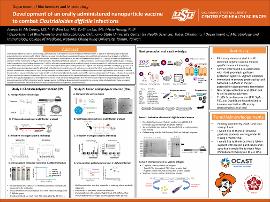| dc.contributor.author | McCreary, Joseph H. | |
| dc.contributor.author | Liu, Yi-Wen | |
| dc.contributor.author | Lin, Yu-Shan | |
| dc.contributor.author | Huang, I-Hsiu | |
| dc.date.accessioned | 2023-11-02T20:46:43Z | |
| dc.date.available | 2023-11-02T20:46:43Z | |
| dc.date.issued | 2023-02-17 | |
| dc.identifier | ouhd_McCreary_developmentofanorally_2023 | |
| dc.identifier.citation | McCreary, J. H., Liu, Y-W., Lin, Y-S., and Huang, I-H. (2023, February 17). Development of an orally administered nanoparticle vaccine to combat Clostridioides difficile infections. Poster presented at Research Week, Oklahoma State University Center for Health Sciences, Tulsa, Ok. | |
| dc.identifier.uri | https://hdl.handle.net/11244/339918 | |
| dc.description.abstract | Clostridioides difficile is a gram+, spore forming, toxin producing anaerobe that is found throughout the environment. C. difficile is the leading agent of hospital acquired infections. Symptoms of C. difficile infection can range from diarrhea to pseudomembranous colitis and if left untreated can lead to death. C. difficile is currently only treated with 3 antibiotics Metronidazole, Vancomycin, and Fidaxomicin. All these antibiotics are non-specific to C. difficile and have the side effect of killing the normal microbiome of the gut. This microbiome helps to keep the body resistant to C. difficile infections, and its destruction can lead to relapses of disease. Ongoing work in our lab is looking at preventing C. difficile infections using a nanoparticle based oral vaccine. In a mouse model of C. difficile infections, we previously demonstrated that intraperitoneal injection of a vaccine composed of the receptor-binding domain of C. difficile toxin B (TcdB) with chitosan and poly-g-glutamic acid were effective in inducing antigen-specific IgA and IgG antibodies. Continuing this research, we later demonstrated that rTcdB encapsulated in a polypeptide-based polymer and delivered orally produces a long lasting and robust antibody response. These robust antibody responses to the C. difficile toxin were enough to prevent disease within a mouse model, however, it was not able to reduce bacteria burden leaving the potential for asymptomatic spread and relapses of disease. In my project, I wish to continue this research in two ways. First, by continuing the optimization of the nanoparticle delivery system. To do this we propose using a nanoparticle polymer that specifically targets M-cells lining the intestine and be pH activated. We hypothesize that this will improve antigen immunogenicity and provide better protection against C. difficile infections. Second, evaluate several C. difficile surface proteins immunogenicity in a mouse model. We hypothesize that a two-target approach may decrease the bacterial load and lead to complete protection against C. difficile infections. | |
| dc.format | application/pdf | |
| dc.language | en_US | |
| dc.publisher | Oklahoma State University Center for Health Sciences | |
| dc.rights | The author(s) retain the copyright or have the right to deposit the item giving the Oklahoma State University Library a limited, non-exclusive right to share this material in its institutional repository. Contact Digital Resources and Discovery Services at lib-dls@okstate.edu or 405-744-9161 for the permission policy on the use, reproduction or distribution of this material. | |
| dc.title | Development of an orally administered nanoparticle vaccine to combat clostridioides difficile infections | |
| osu.filename | ouhd_McCreary_developmentofanorally_2023.pdf | |
| dc.type.genre | Presentation | |
| dc.type.material | Text | |
| dc.subject.keywords | Clostridioides difficile | |
| dc.subject.keywords | vaccine | |
| dc.subject.keywords | prevention | |
| dc.subject.keywords | nanoparticle | |
